
22.04.2019
Erik Del Búfalo speaks with artist Ana Alenso about the questions her work activates around the imaginaries of uncertainty within the Venezuelan present, perpetuated by a voracious petro-state.

Without a doubt, Venezuela’s most recent art has been marked by its political situation since the late 1990s; either in an explicit way or as a complaint, in an implicit way or from confusion. The work of Ana Alenso combines these two perplexities. The following conversation with the artist was intersected by a strange dialectic, of mutual estrangement but also of mutual closeness. As if we translated it to a foreign language from a mother tongue that was taken from us. Maybe that is always the case when it comes to translating a physical fact into words. Mainly because we did not want this text to be a mere juxtaposition of general ideas about a concrete, silent, unrepeatable, unavoidable fact: the work itself. We also did not want the author’s opinion to overlap with the truth of the art on its own. Works of art always have their own vision of the world, which can only be expressed in that same work. What’s left for the artists is perhaps to become a privileged, intimate interpreter: the oracle of a goddess that only she has seen. Focused on the pursuit of that message, we established this dialogue, spaced out in time, interrupted by space.
Erik del Búfalo: Your work, Ana, clearly reveals the ups and downs of oil wealth as something that escapes mere linear temporality, or the idea of a proper historical time to the modern West, whose faith is based on progress. Rather, your work suggests a circular time, a mythical time, similar to the time defined by the natural cycle of the seasons of the first civilizations. Perhaps because oil, more than being produced, is extracted from nature, Venezuela’s wealth has never depended on the will of its citizens, but on the cycles of extraction and the oscillations of revenue. This natural resource has been for us ambrosia, a magic gift. Do you think that your work tries to interpret this logic of the alienation of oil wealth? Does the temporality of the “extraction,” the alienation or deterritorialization of the subsoil, play an essential role in your work?

Ana Alenso: I mostly work with the feeling of uncertainty that the era of oil has left us. In the history of oil extraction, I find a cosmos of conflicts and paradoxes, ideas of progress and destruction that, nowadays, constitute many of the global power struggles that have ended up seizing our collective imagination, even more so in countries made up of a petro-state, such as Venezuela. In my work, I seek to reveal the vices of this petrocultural imaginary and its potential iconicity derived from the use of objects, photographs, videos, and other industrial elements. For example, in my piece 24/7 (2014), a toy tractor wheel rotates slowly and infinitely over a mirror. In this case, I could say that the engine in the “subsoil of the piece” is the impulse that represents the idea of progress and modernity in the Venezuela of the sixties that, like this dismantled wheel, fails. It is lost and hallucinates with the reflection of his eternal return.
EDB: That what you call “eternal return” also suggests the idea of a centrifugal force, of a liquefaction of Venezuelan modernity, imported precisely with the resources of oil. It’s an inflated modernity that ends up becoming hyperinflation, as is clearly seen in your piece 1,000,000%. (2018). In some way, the relationship between money that enters and disappears quickly is culturally reflected as a spiral, a cyclone of ruins. In your piece, do you see any relationship between this failed modernity of which you speak and the possibility of another type of country? Is there a future country imagined in your work?
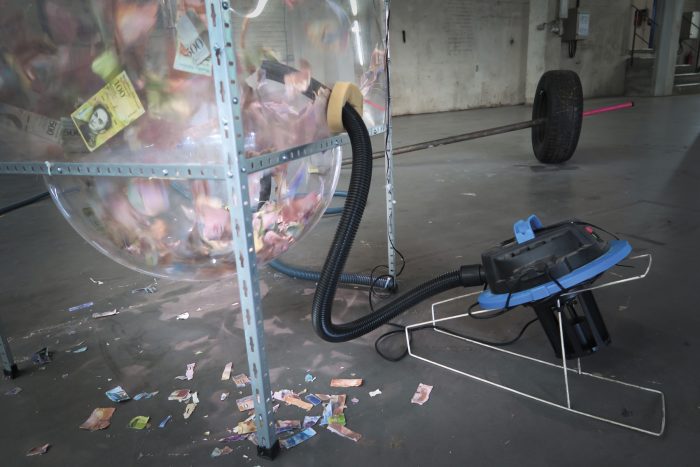
AA: The 1,000,000% installation consists of a circuit made up of a money cyclone prototype [1], two barrels of oil, pieces of cars, hoses, LED screens and motors that are mechanically connected. The title of the piece refers specifically to a turning point in the history of hyperinflation in Venezuela when the International Monetary Fund (IMF) predicted a 1,000,000% hyperinflation by the end of 2018. Exactly the same rate of hyperinflation that the Germans lived through during the interwar period in 1923. Hyperinflation, seen as an everyday experience of acceleration and dissolution, resembles or recalls the culture of chance, where everything can happen. It is also not surprising that these circumstances reinforce the belief that the country’s oil reserves are our only and inexhaustible life insurance. In September 2018, the 3 million BsF, collected in the cabin of the cyclone of money, was equivalent to just 20 cents on the black market. In the cabin of the installation, hundreds of bills fly in intervals of just a few minutes, until, with the passing of days, the force of the air inside the cabin ends up disintegrating them. It is a temporary, albeit an allegorical process that shows not only a bankrupt economy but also the decline of a society, methodically impoverished by a corrupt system.
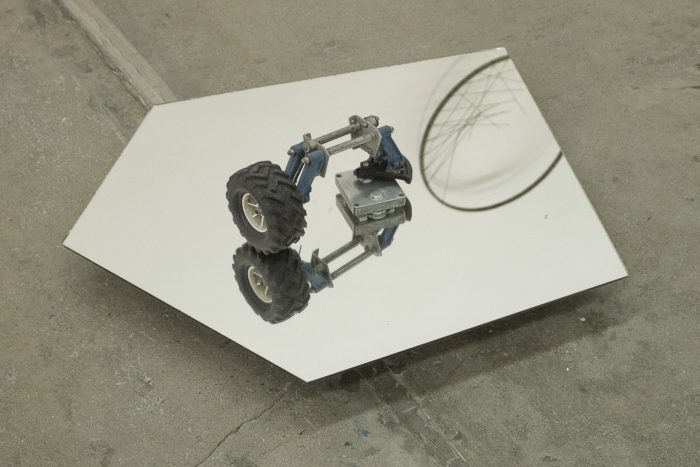
In this sense, and seeking to probe more into your question, I think that the idea of a future country in my work presents itself more like a question. In general, I address issues of current ecologies, economies, and geopolitics with a critical intention and through a predominantly poetic and abstract language. However, paradoxically it is difficult for me to imagine the possibility of another type of country in my work as long as the extractive policies of the country continue to encourage state corruption, to the point of justifying the partial destruction of the Amazon (to name a specific case the mining arch of the Orinoco )[2].
This state of vulnerability, almost amnesic, of the nation, is what allows me to do a dystopian exercise…
EDB: Perhaps, if something has been common in recent years in Venezuela, even before the arrival of Chavismo, it is the impossibility of imagining a future other than that of an oil country. Now that oil aims to disappear in the coming decades as a primary source of energy, it seems almost impossible to project ourselves as a nation. In your work, this circular time, the time of the extraction and the oil revenue present themselves as an apocalypse, as an end without destination. This makes me think of artists like Rolando Peña who, since the seventies, denounces oil extraction as the only possible scenario for Venezuela. However, in your work, which clearly belongs to another generation, the complaint is even more pessimistic. Not only in its ecological character but in its capacity to destroy us as a society without, even, the possibility of imagining other exits. In what sense does the denunciation that your work goes through not only denounce oil as a source of unique wealth, as a neocolonial result, but, as you have affirmed, as an impossibility of collective imagination, of the failure of a national vision?
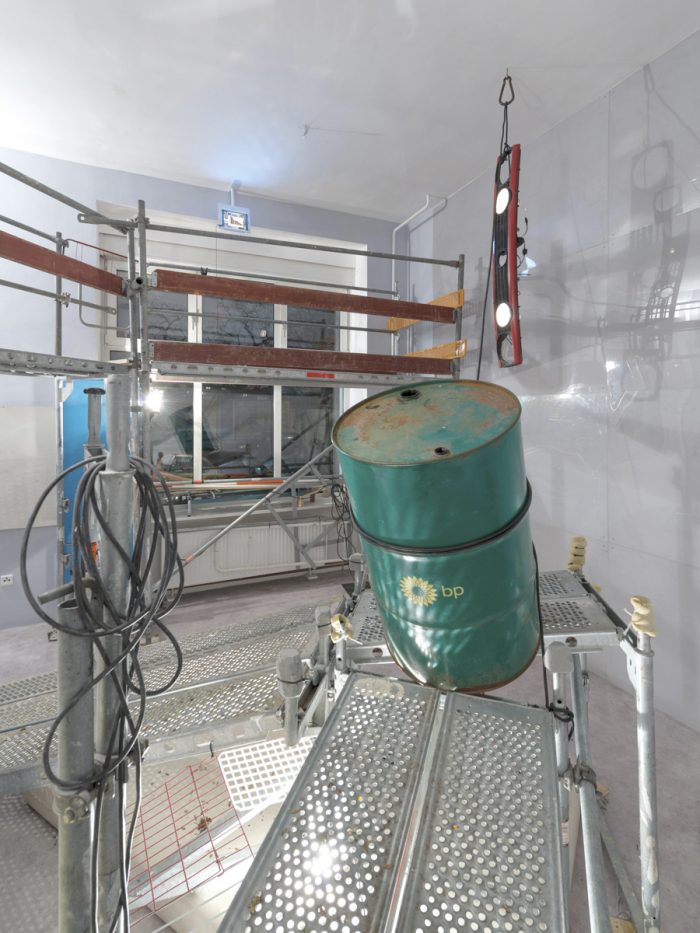
AA: It is almost impossible for us to project ourselves as a country because we are a clear consequence of the oil alienation. The so-called “curse of resources,” as Richard Auty called this phenomenon; where the abundance of natural resources leads to misery. I grew up in a generation that has witnessed the destruction of the economic apparatus and public institutions and, in a rather drastic way, where corruption has established itself as a daily practice of survival. This state of vulnerability, almost amnesic, of the nation, is what allows me to do a dystopian exercise, where representative elements of the oil history and culture are transformed into sculptural objects. They are precarious constructions and industrial waste that are transformed into platforms for discussion and contemplation. In my work, perhaps as in geopolitics, each object has a role within the assembly, and that is why, in many of my sculptures, the elements are held up only by the tension and compression between their parts.

EDB: However, this “tropical curse”, this sadness of the tropics, which is its neocolonial or mono-export dependency on raw materials, does not appear in your work as a mere “fact”, but rather as a structure, that is: as a set of relationships in tension that seeks to reproduce itself. The curse, however, implies two things: that there is a condemnation that comes to the country from the outside and, on the other hand, that there is something in the order of discourse that plunges us into evil (curse). In your work, this is revealed as exteriority because it is something that we see and not only something that makes us see; it is more object than subject, more matter than experience, more container than content. The perception, marked by how you take the viewer through your work in the space, is still in a place not discovered, not explored. Is there also a virgin land in your work, a country that remains safe from the curse? Where is it? If it exists, how is that country?
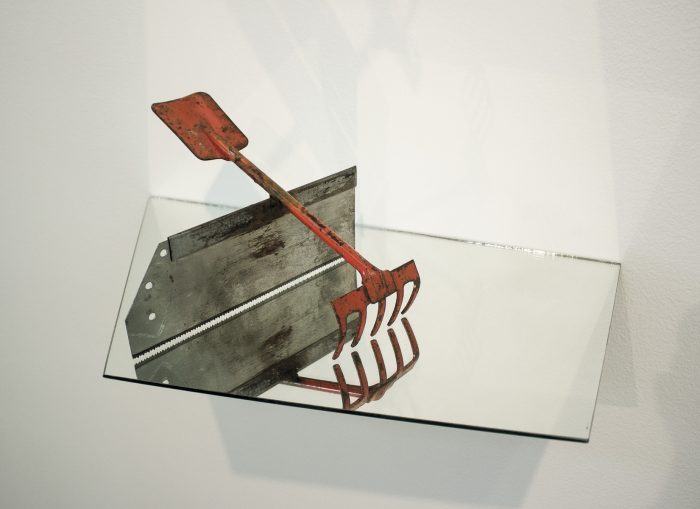
AA: In the piece, there is a hidden content that originates in the combination of the elements and their ability to refer to other latitudes, in certain pieces the leitmotiv is the Venezuelan case, in others the logics of extractivism or climate change. The point is that in the creative process, starting from the collection of materials, there are moments of improvisation, recycling, and manipulation that provide an empirical knowledge from which states of precariousness, fragility, and tension in the piece are generated. This sensitive element is a vehicle for allegories and an invitation to dialogue with others. If I imagined a country in my work, it would be the country of survival, a country thought from exile, a country destined to change and recycle constantly.
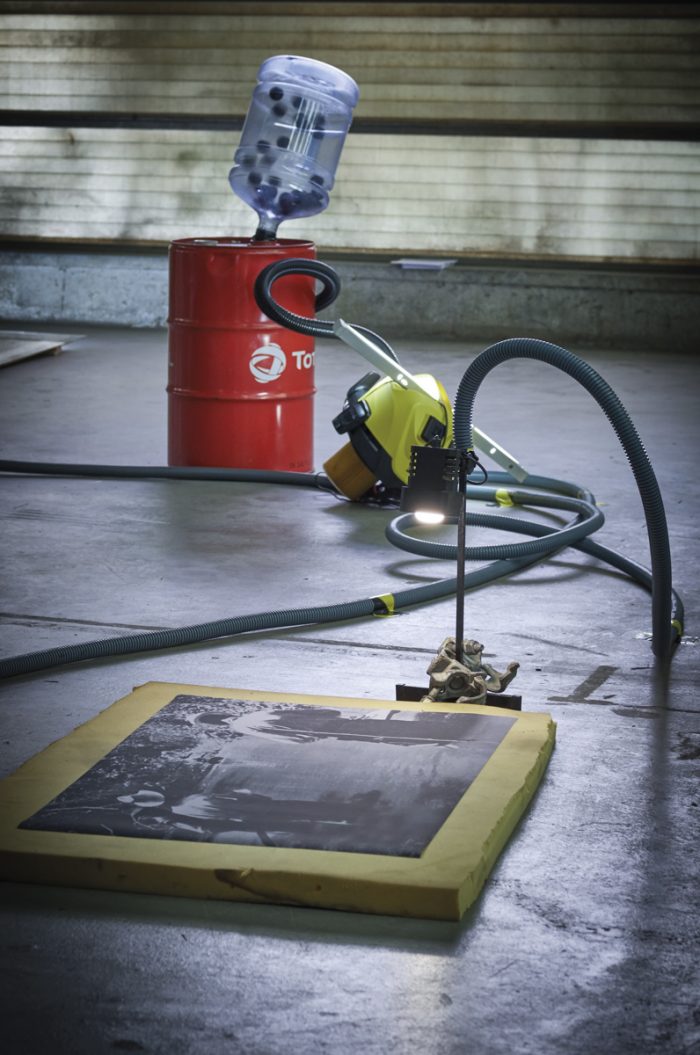
EDB: This reflection forces me to ask: is oil not also the metaphor of exile, that wealth that, coming from the national subsoil, progresses in other parts of the world? Would the Venezuelan nation, in its exodus, not ultimately be the final limit of a lost wealth?
AA: I think it’s a good metaphor because in both processes (oil extraction and exodus) a profound mutation occurs, a change of chemical and mental state, which leads to its integration, both to other production systems, in the case of oil, as to other societies, in the case of Venezuelans.

EDB: To conclude, Ana, in this drainage of resources and human beings, how do you conceive a Venezuela within the context of Latin America? Certainly, we are not the first country that, in a Latin American context, has suffered from a monoproductive economy and, also, not the only one where an archaic temporality is presented, thanks to a more or less failed modernity. However, the Venezuelan process is particularly paradoxical because the exploitation of raw materials that the country goes through is not happening so much from the outside—as an imperialistic imposition—but from an internal social assertion, carried out by supposedly progressive forces.
AA: I believe that the extractive policies in the Latin American context are sustained under a network of powers anchored to their colonial pasts, where deep political, social and ideological wounds coexist. Because of this, I find it particularly difficult to differentiate the standpoints of extraction by the governments of the region, paraphrasing Svampa (2013), that is to say that these are “progressive neo-developmentalists” or “liberal neo-developmentalists,” there is a basic consensus (consensus of the commodities) that translates into a process of dispossession and violence on the territories and their communities. This said I believe it is crucial that these reflections lead us not only to consider the role of geopolitics in the conservation of ecosystems but also to recognize the anthropocentric nature of extractive practices and the urgent need to rebuild and strengthen our relationship with nature. For this reason, I would like to conclude this conversation with the inspiring words of the U’wa, inhabitants of the deep jungles of eastern Colombia and great defenders of their territory: “Oil is ruiría and ruiría, it is the blood of Mother Earth…to take oil it is, for us, like killing our own mother.”
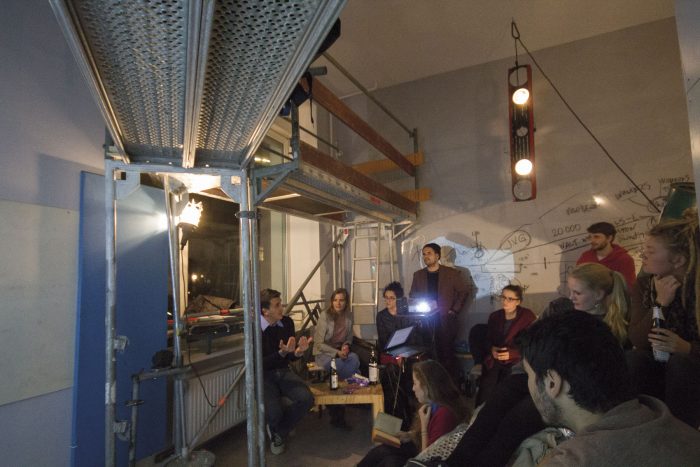
Ciclón del dinero (2015).
The Orinoco Mining Arc is an area in Southern Venezuela of more than 100,000 km2, rich in various minerals such as gold, copper, diamond, and coltan; and stated by decree, in 2016, by the Maduro government to be intensively exploited. Mafias, Colombian guerrillas, military forces and common criminals vie for plots of their territory. Multiple organizations have denounced crimes against human rights, as well as ecological crimes.
Comments
There are no coments available.